
-

Big Sunspots and Prominences
This photo was taken on the morning of July 9th, 2023 in Beijing, China. It is a very clear day with good astronomical seeing. However, the temperature is very high. At this moment, a huge sunspot group has appeared at the edge of the sun and is expected to appear in the center of the sun in a week. This sunspot is large enough to be visible to the naked eye after using a solar glasses and the sunspots's number is AR3363. Around this sunspot, there are also solar flares, which are very active areas on the solar surface. In addition, various solar prominences can also be seen at the edge of the sun. My equipment: Lunt 152T solar telescope, ZWO ASI432MM, Televue 4X and Rainbow RST-135. -

Active Area Full of Solar Disk
This photo was taken on the morning of June 22, 2023 in Beijing, China, which was almost the longest day in the Northern Hemisphere. As the Sun approaches the peak of its active cycle, which may arrive sooner than originally predicted. Sunspot, filaments, flares and prominences can be seen in the photos. The north pole of the sun is at the top of the picture. When carefully observed, it can be found that the active region of the sun is concentrated in the middle of the northern hemisphere and the middle of the southern hemisphere of the sun, and the relative activity of the polar and equatorial regions of the sun is low. My equipment: Lunt 152T solar telescope, ZWO ASI432MM, Televue 2X and Rainbow RST-135. -
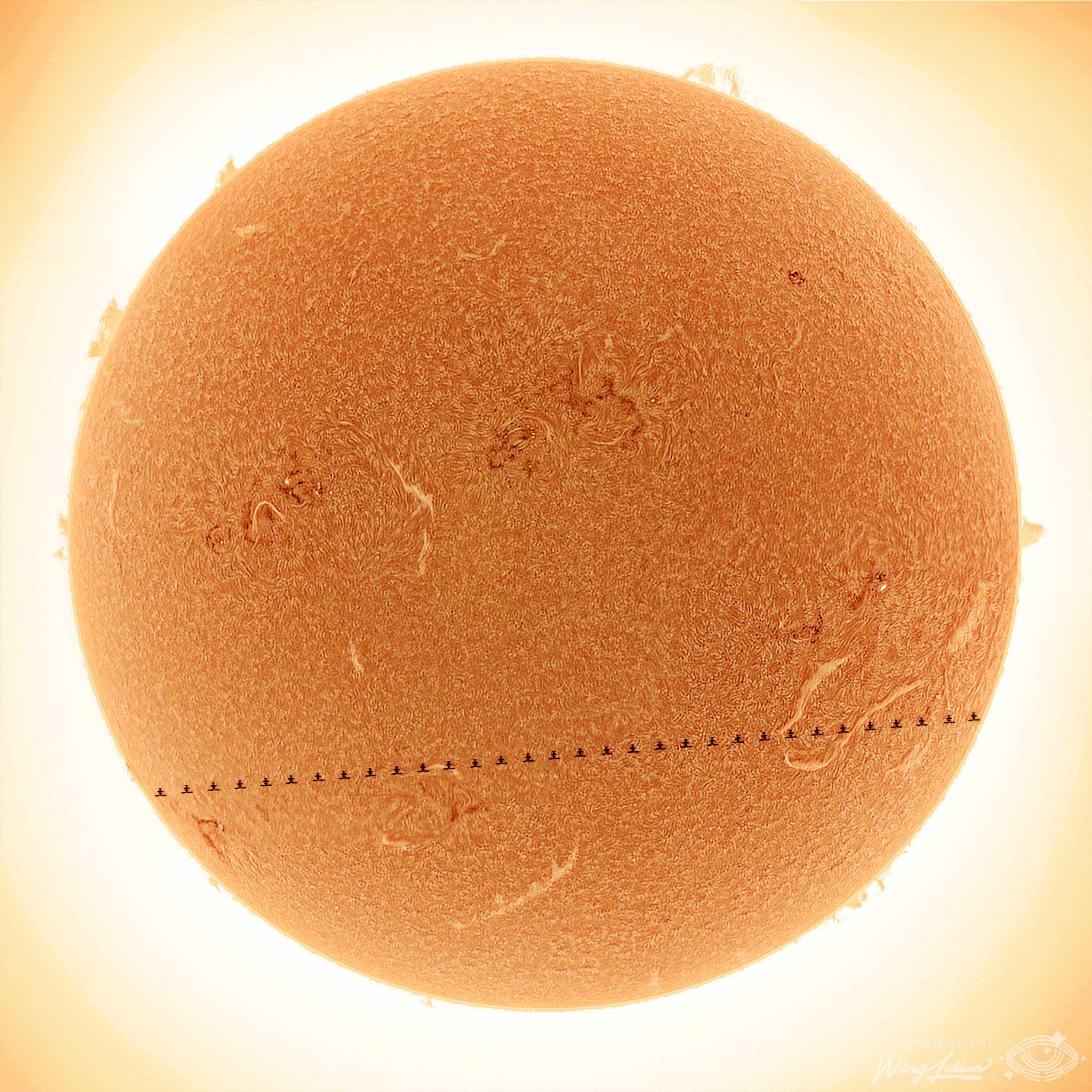
China Space Station Transits Active Sun
This photo taken at noon on September 10, 2022 in Beijing shows the full solar surface. At the lower right of the sun is the sunspot active area numbered AR3092. In this area, you can see a long snake shaped dark stripe, which has stretched for almost 390000 kilometers and has been on the surface of the sun for nearly two weeks. My equipment: Lunt 152T solar telescope, ZWO ASI432MM, Televue 2X and Rainbow RST-135. -

Sun Erupting
This photo was taken at noon in Beijing, China on April 19, 2022. In the picture, this area of the sun is one of the most active solar areas in recent years. There are a large group of sunspots, AR2993 and AR2994, around which flares and solar projectiles continue to be produced. At the edge of sun, a new sunspot is coming. My equipment: Lunt 152T solar telescope, ZWO ASI174MM, Televue 4x and Rainbow RST-135. -
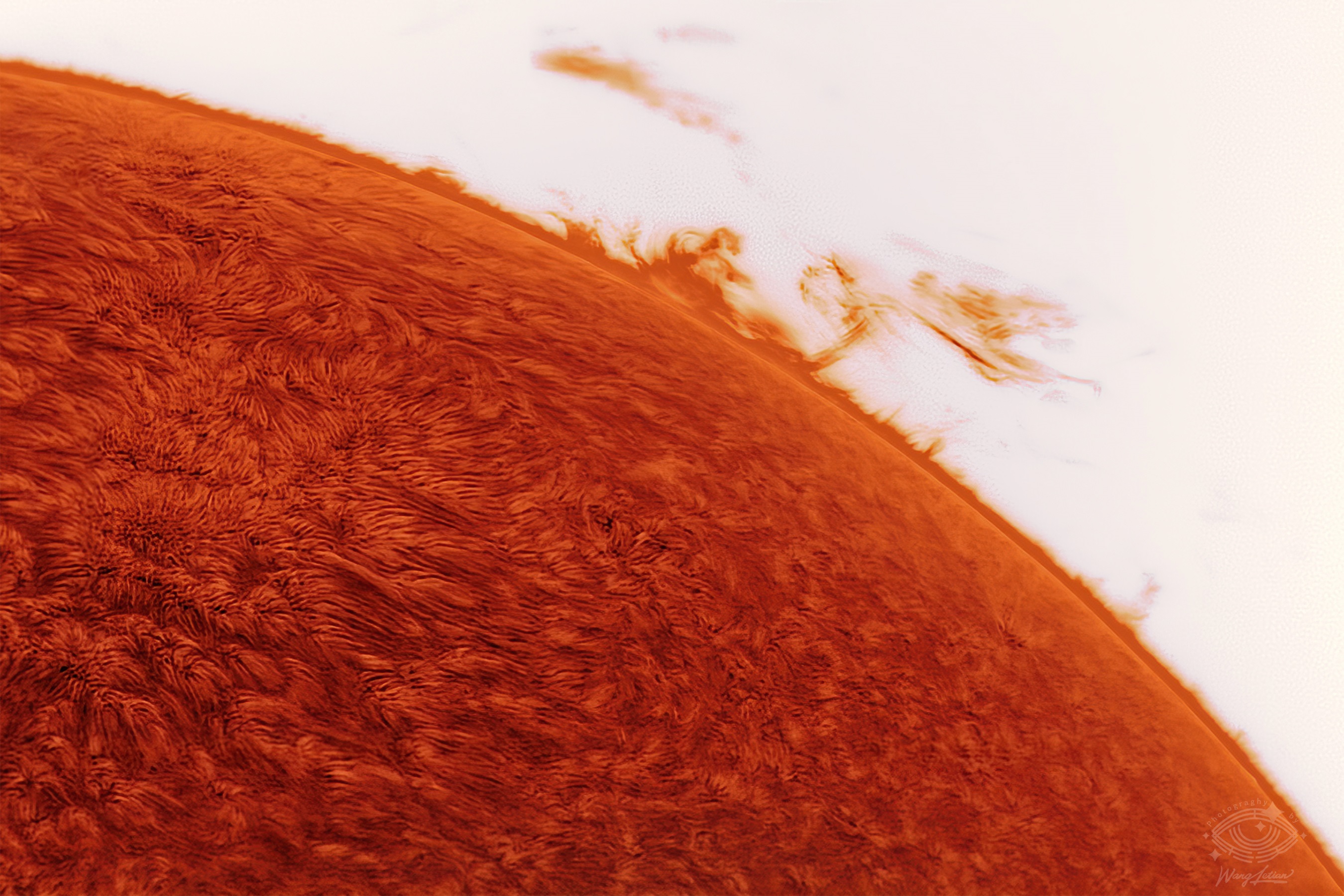
a Huge Prominence over the Sun
With the arrival of the sun's 11 year activity cycle, the sun has entered an active state. This photo was taken at noon on June 2, 2022 in Beijing, China. The photo was taken in an active area on the southeast edge of the sun. After reverse color processing, there are no sunspots in this area, but intense chromospheric activities are under way. The rising solar prominence has risen to more than 50000 kilometers from the sun's surface. My equipment: Lunt 152T solar telescope, ZWO ASI174MM, Televue 4X and Rainbow RST-135. -

China Space Station, Sunspots and Solar Prominences
The photo was taken on April 6th, 2022 at local time in Beijing. In this picture, the largest sunspot number is AR2978. With sunspots, you can see nearby bright areas - solar flares, and dark stripes - prominences on the sun's surface. Prominences can also be seen at the edge of the sun. At this time, the China space station is passing quickly in front of the sun, leaving a black shadow. My equipment: Lunt 152T solar telescope, ZWO ASI174MM, Televue 2X and Rainbow RST-135. -
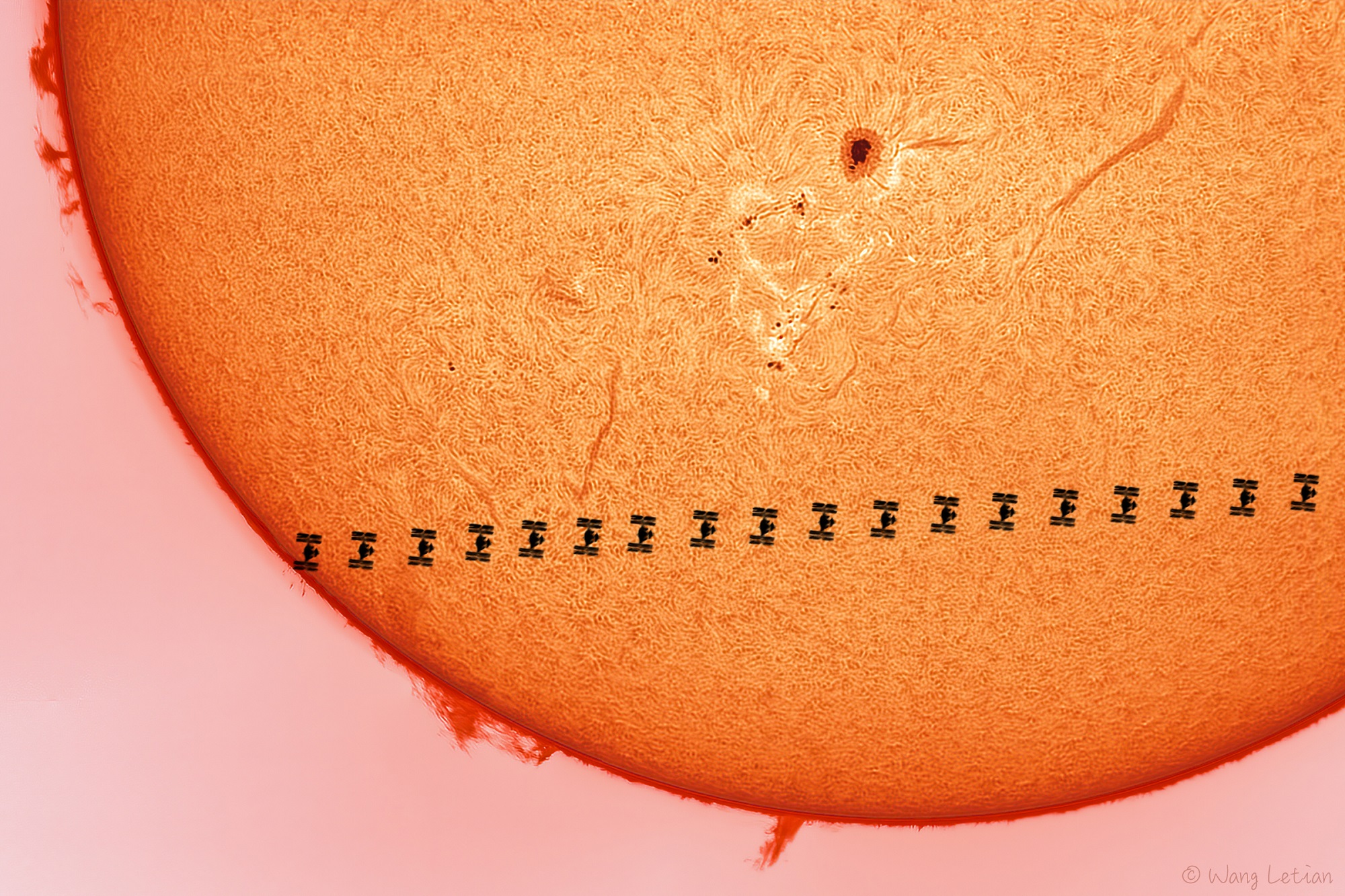
Space Station, Sunspots and Solar Prominences
The photo was taken at noon on April 2nd, 2022 at local time in Beijing. The sun has been in a very active state recently. In this picture, the largest sunspot number is AR2978, which can even be seen by the naked eye at sunrise or sunset. The sunspot number of the following group is AR2981, and there is a very small sunspot number AR2982 on its left. With sunspots, you can see nearby bright areas, solar flares, and dark stripes - prominences on the sun's surface. Prominences can also be seen at the edge of the sun. At this time, the international space station is passing quickly in front of the sun, leaving a black shadow. My equipment: Lunt 152T solar telescope, ZWO ASI174MM, Televue 2X and Rainbow RST-135. -
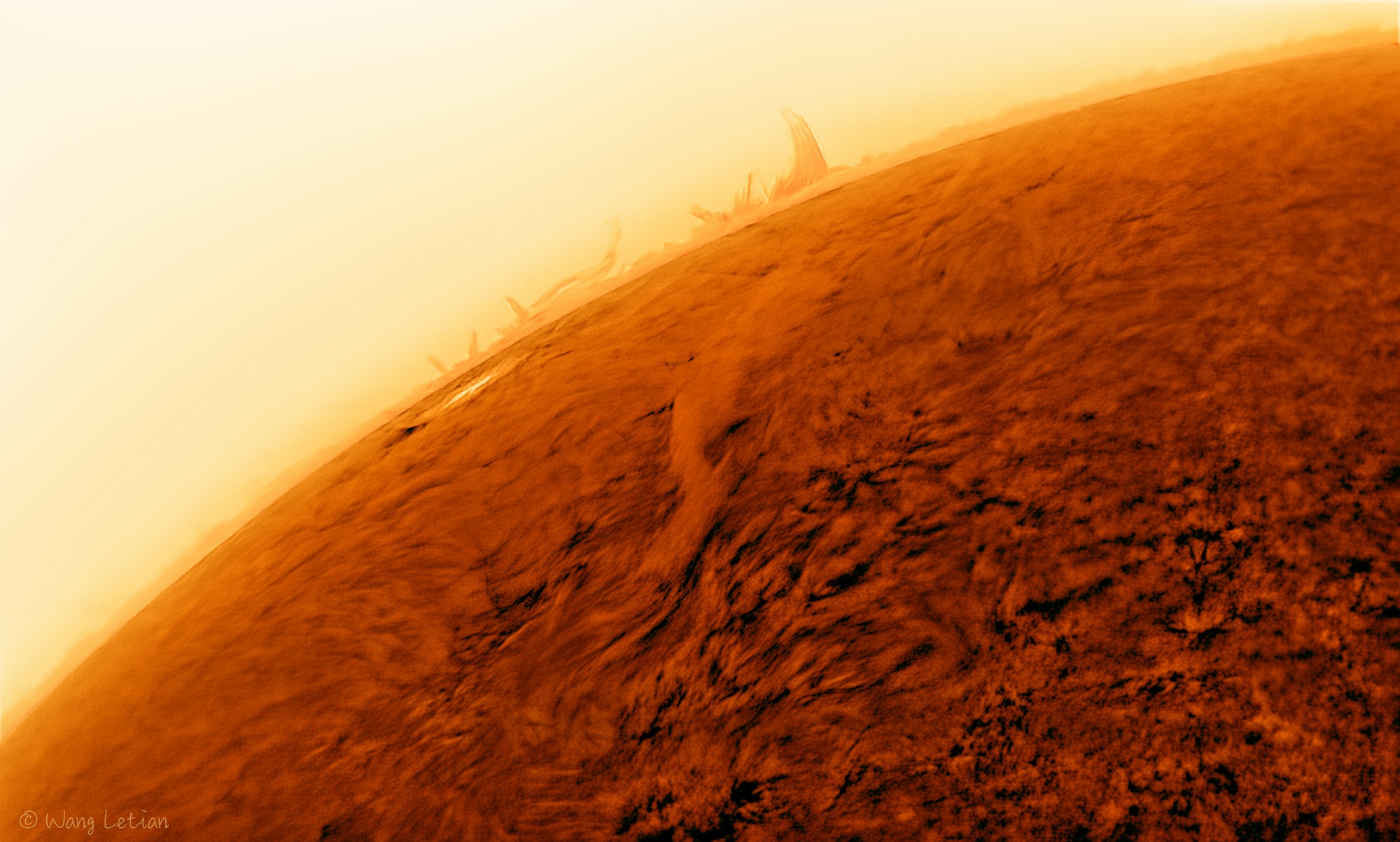
Active Solar Surface
The photo were taken in the afternoon on March 27, 2022 at local time at Beijing. There are many elements on the surface of the sun. Because the color of the photo is reversed, the white spot in the photo is sunspot at the edge of sun. This sunspot has just appeared and looks very active at present. It is numbered AR2978. In the center of the image, we can see white stripes, which are prominences on the surface of the sun. My equipment: Lunt 152T solar telescope, ZWO ASI174MM, Televue 4X and Rainbow RST-135. -
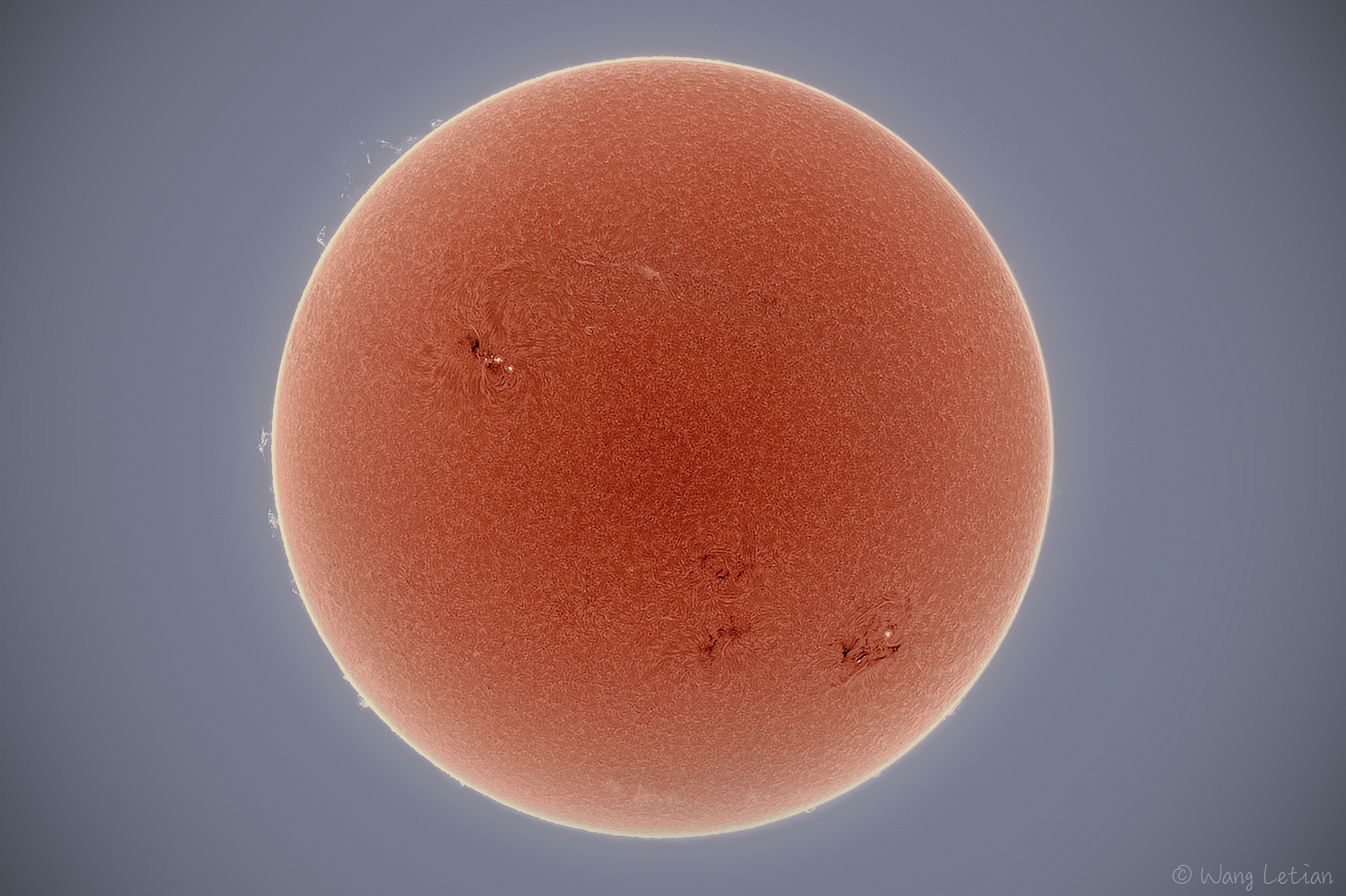
Orange Active Sun
The photo was taken in the morning on Oct 31, 2021 at local time at Beijing. In the photo of the sun, the top is North Pole of sun, there are many elements on the surface of the sun. It includes two obvious sunspot groups on the current solar surface, at middle left is AR2891, sunspot AR2887 is at the bottom right of the sun. next to it and AR2864 at the edge of the sun. In addition, we can see several white stripes, which are prominences on the surface of the sun. At the edge of the sun, we can still see the solar prominence. My equipment: Lunt 152T solar telescope, ZWO ASI1600MM Pro, and Rainbow RST-135. -
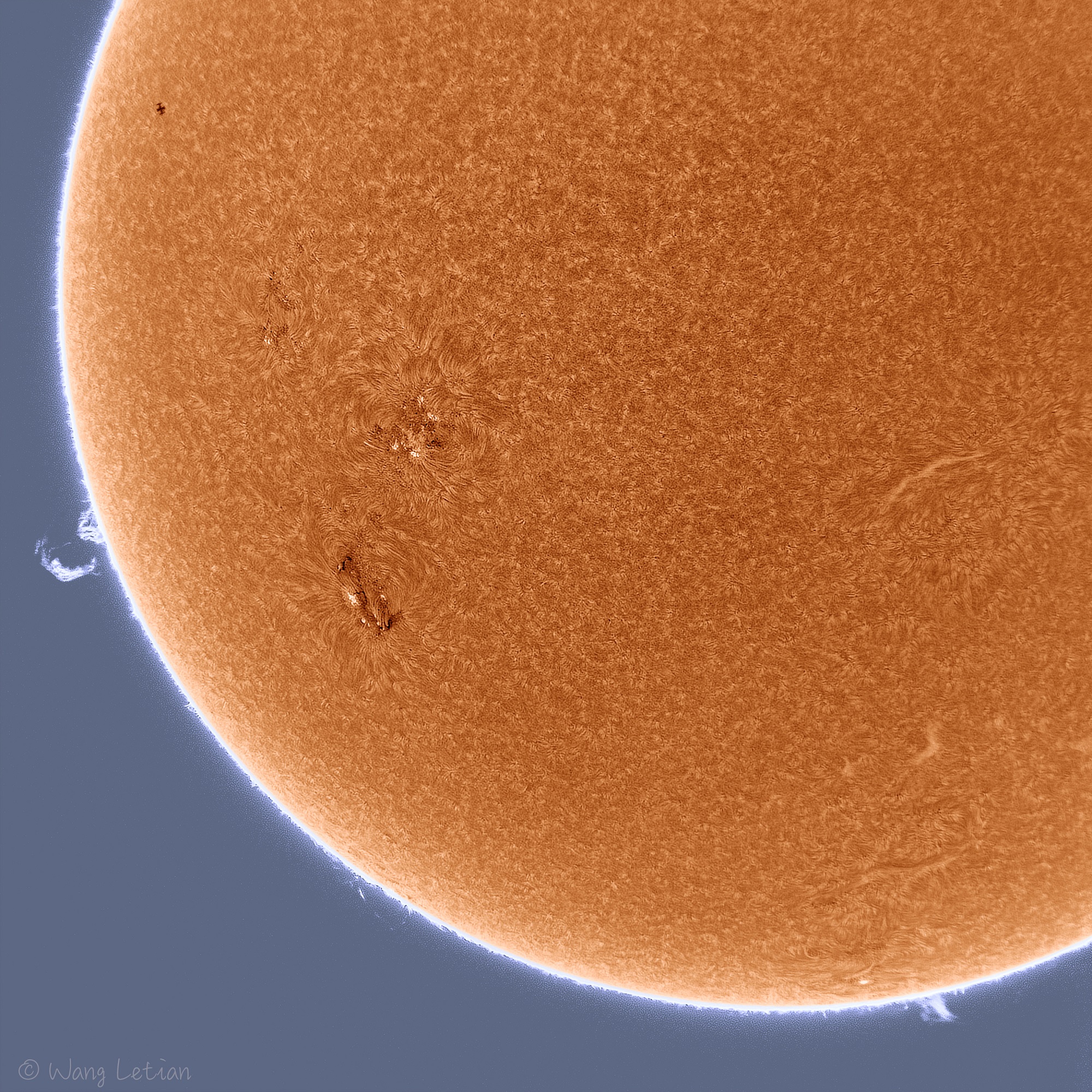
Active Sun with China Space Station
The photo was taken at noon on September 11, 2021 at local time at Beijing. In the image of a quarter of the sun, although only part of the sun, there are many elements on it. It includes four sunspot groups on the current solar surface, of which the largest two groups are AR2866 and AR2868, AR2869 next to it and AR2864 at the edge of the sun. In addition, we can see several white stripes, which are prominences on the surface of the sun. At the edge of the sun, we can still see the solar prominence and its three-dimensional shape, and some arched shape prominences. Prominences and flames soar from the surface of the sun into the air, and then fall back to the surface of the sun. In the picture, in addition to the sun element, there is a small element. Its shape is like "1+1". It is China space station. At that time, it is composed of the Tianhe core module in the middle, a return module and a cargo spacecraft at both ends of the space station. My equipment: Lunt 152T solar telescope, ZWO ASI1600MM Pro, Televue 2X lens and Rainbow RST-135. -
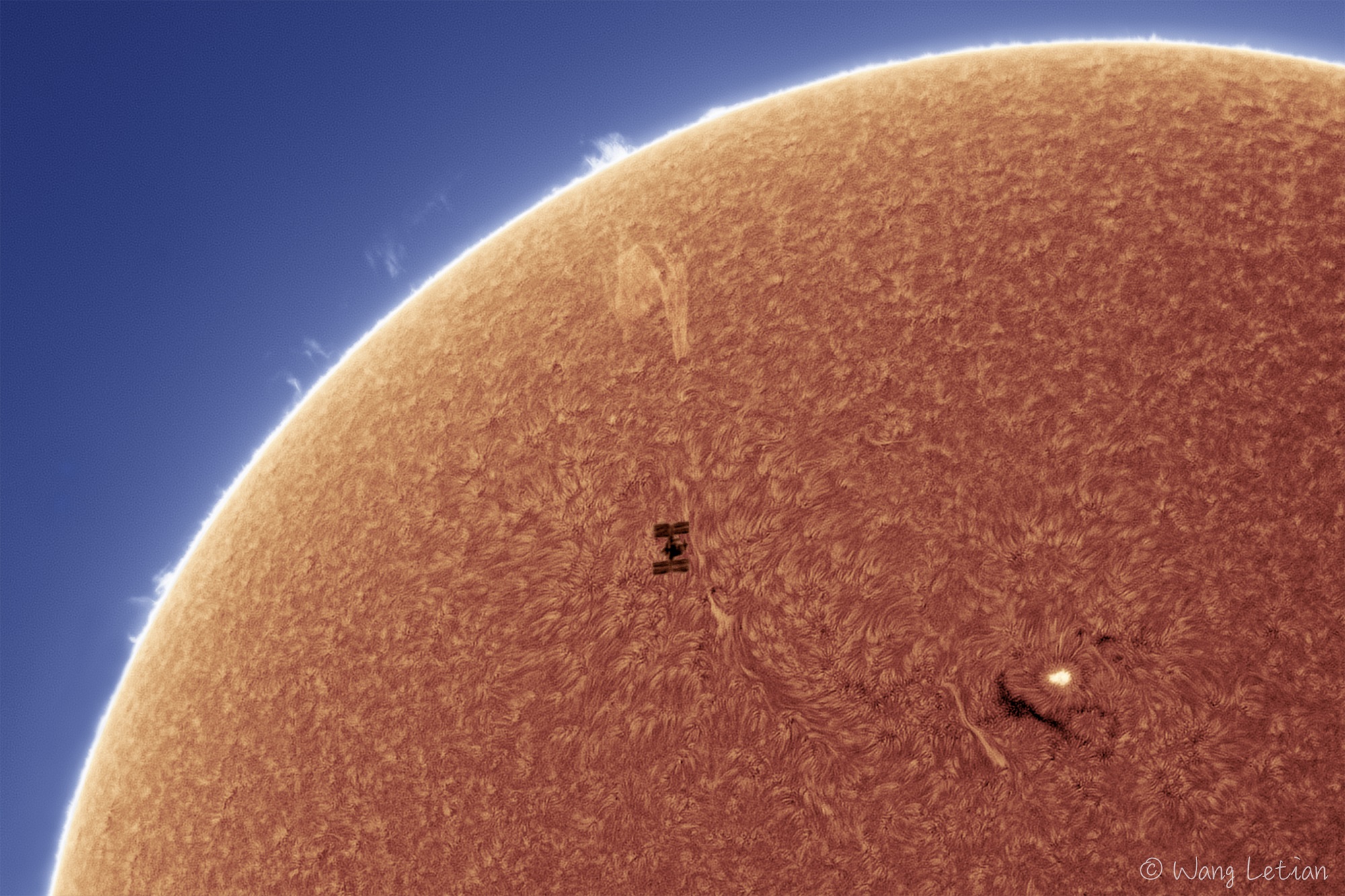
ISS Transits the Sun
I take this image on 2021 June 18th at about 2:28p.m. in Beijing. On the right side of this photo, there is a very obvious sunspot, called AR2833. In addition, there is a huge stripe on the left side, which is a flame rising above the surface of the sun. At this time, ISS is flying over the surface of the sun. The ISS is about 56" in size and 492 km away. My equipment: Lunt 152T solar telescope, ZWO ASI 1600MM Pro,Televue 2x lens. -
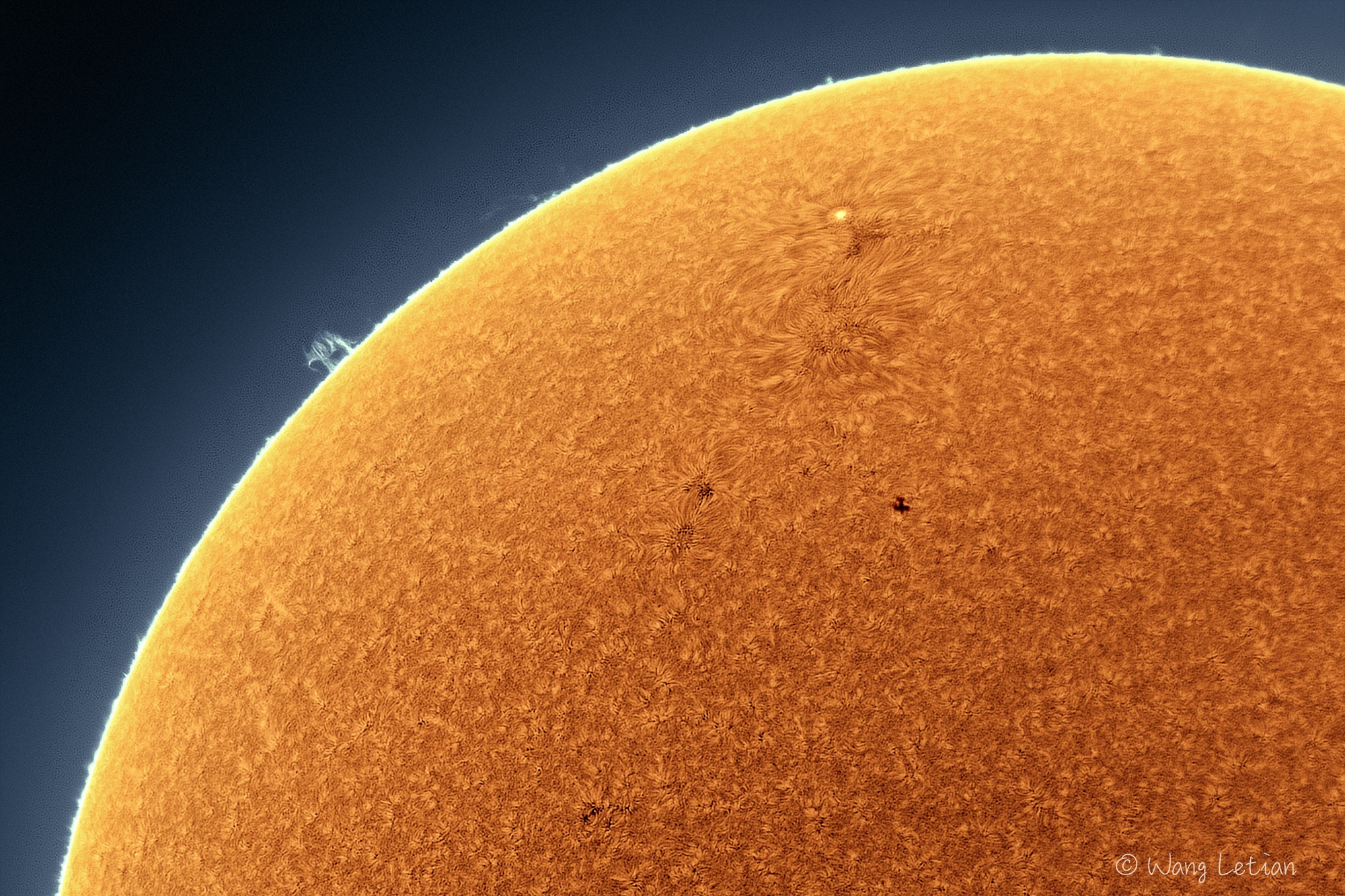
China Space Station Transits the Sun
I took this image at 2021 June 6th 10:55 AM in Beijing, China. In the images, China Space Station (CSS) was passing sun. At top of my image, there is a large sunspot called AR2827. At right of the sunspot, it is CSS. The shape of CSS are "+" and "-". The larger cross shape is the "Tianhe" core module, which is composed of the cabin and solar panels. The smaller straight line is the cabin and solar panels of the Tianzhou-2 cargo spacecraft launched at 2021 May 29th. In addition, the active plage of the sun can be seen on the lower left side of the sunspot, and a clear prominence can be seen on the left side. My equipment: Lunt 152T solar telescope, ZWO ASI 1600MM Pro, Televue 2x lens. -
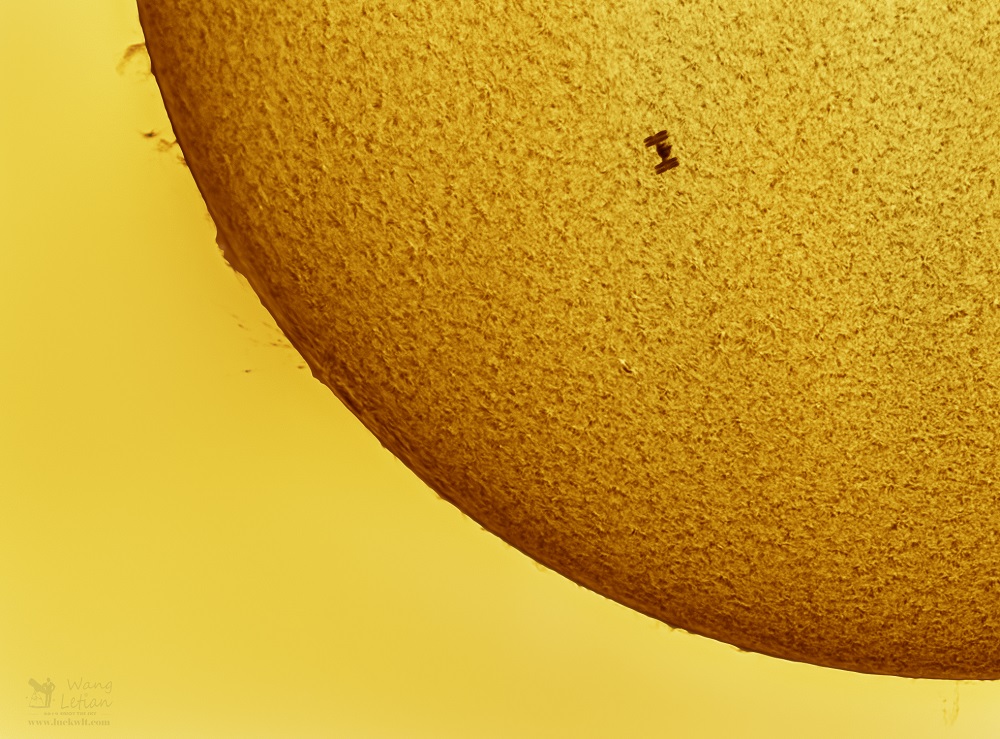
the ISS Transits the Sun
I took this image on 2019 April 7th 13:24 at local time in Beijing, China with my Lunt 152T solar telescope, TV 2X barlow and ZWO ASI 174MM CCD.In the images, ISS was transitting sun. The duration of the transit is about 0.7 second. The distance of ISS is about 500 kilometers.In my image, there is a larger sunspot at downleft edge of the sun. It is AR 2738. Sunspots have not appeared on the surface of the sun for a long time. -
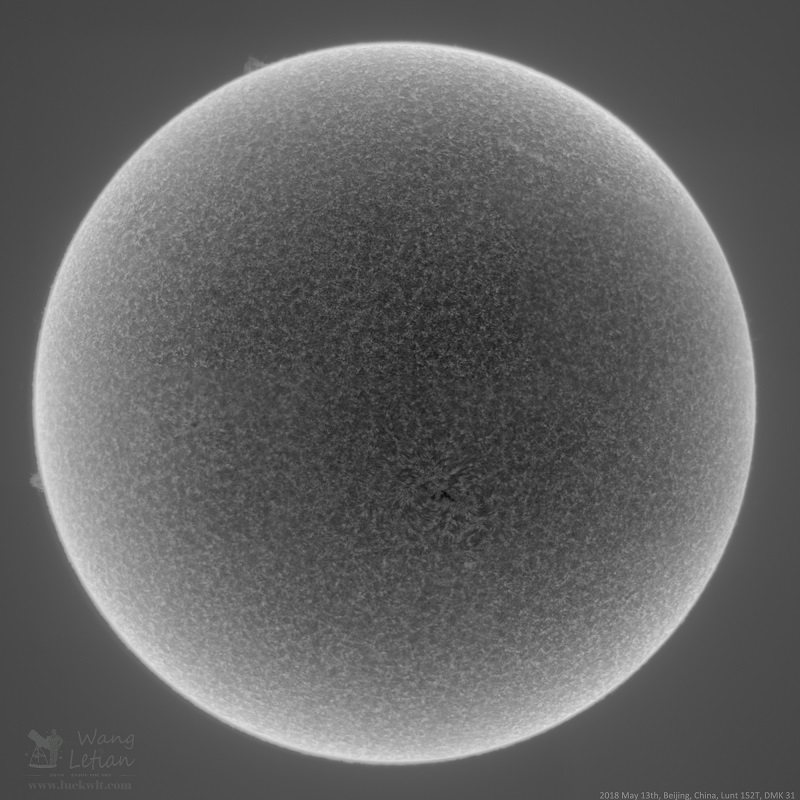
Hydrogen Alpha Sun
I take this image on 2018 May 13th at about 2PM in Beijing China. As we know, sun has a solar cycle. The cycle is about 11 years. And this year in 2018, the sun is less active. That means the sun surface is clean usually, however, in my image, only a few solar prominence could be observed at the edge of the sun. I inversed the color of the sun surface. My equipment: Lunt 152T solar telescope, DMK 31 CCD -
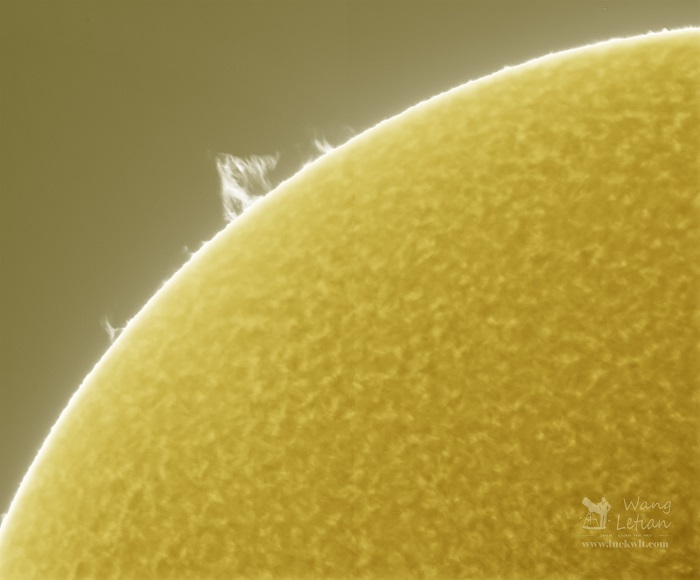
Solar Prominence
I take this image on 2018 April 15th at about 12 o'clock in Beijing China. The sun surface is clean, however, large solar prominence and details could be observed at the edge of the sun. I inversed the color of the sun surface. -

Solar Filament with Sunspots
A large solar filament appeared several days across the sun. The region of sunspots AR 2096 and AR 2097 is very active. In addition, the region AR 2104 and AR 2107 at the left side is coming to face us, where has enormous power. This photo I took on June 28th 2014 with my Lunt 152T solar telescope, TV 2X barlow and BM-500GE CCD in the morning at Beijing China. -

a Large Solar Flarebefore Eclipse
A large solar flare appeared just several hours before the hybrid solar eclipse on Nov 3rd 2013 between sunspots1884 and 1885. The flare is very bright, which looks appropriate because of HDR technology. I use three different exposure time pictures to compose one. The shape of flare changes very fast. The brightness of the flare changes in several minutes.This photo I took with my Lunt 152T solar telescope and DMK31 CCD at Beijing China. -
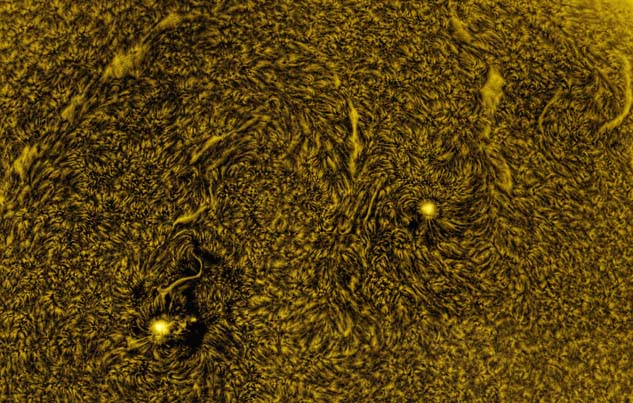
Active Region AR11598 & AR11599
This is the sunspots I took pictures 2012 November 6th in Beijing China. My equipment is Lunt 152T solar telescope BF3400, TV2x barlow lens and DMK31 CCD. -

Active Sun
This is the sun I took pictures on Oct 27th 2012 with my Lunt 152T solar telescope DMK31 CCD at Beijing,China. From the image, we know that the southern area of sun is more active. -

The Path of Venus Transit
June 6th 2012, I drove more than 1200 kilometers away to find a clear day. Finally, the weather was so-so. There were much cloud at the beginning and the final period, but I got a high resolution picture of The Path of Venus Transit. I took this picture at Xi’an, a middle city in China. My equipment is Lunt152T telescope, MX mount and DMK31 CCD camera, TV 2x Barlow. After that I use Registax 6 and Photoshop CS4 compose all the pictures.
Wang Letian All Rights Reserved